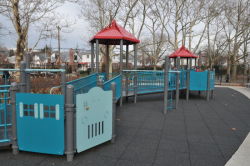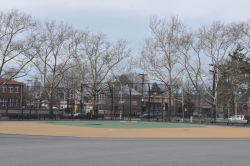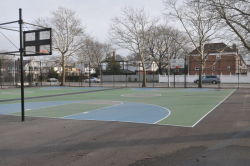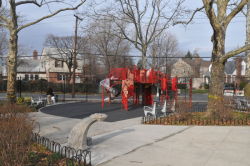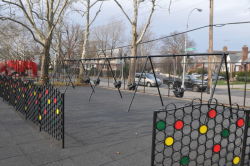Utopia Playground
Utopia Playground
Utopia Playground takes its name from a housing development in Queens that was never built. The Utopia Land Company planned to construct an expansive cooperative community for Jewish residents of the Lower East Side on fifty acres of land east of 164th Street between the communities of Jamaica and Flushing. The land was obtained for development in 1905, at which time the company acquired a $9,000 mortgage to grade streets and divide the land into lots. The plan included industries and a cooperative store. The roadways in Utopia were to be named after Lower East Side streets such as Ludlow, Division, Hester, and Essex.
When the Utopia Land Company found itself unable to secure additional funding, the project was swiftly abandoned. While the dream of the development faded, the project’s name was remembered, providing a name for Utopia Parkway, which in turn lent its name to Utopia Playground.
The word “utopia” comes from Englishman Sir Thomas More’s (1478-1535) book Utopia, written in 1516. As a member of Parliament, More fell out of favor with King Henry VII after a fight over decreased land grants to the Crown. The King imprisoned More’s father as punishment and made More pay a fine to secure his father’s release. More subsequently left public life for a time.
During his hiatus from political affairs, More expressed his enmity toward British government in the form of a satirical work, Utopia. The book depicts an island, called Utopia, where individual needs are subordinated to communal ones, work is compulsory, education is universal, religious tolerance is practiced, and land is communally owned. More then juxtaposes his ideal island with English society, which according to Moore had none of these “Utopian” features.
Henry VIII, whom More often joined in philosophical debates, brought the writer and theorist back into political life. Yet, More once again found himself at odds with the monarchy when he refused to sanction Henry VIII’s break with the Catholic Church and would not accept Parliament’s rejection of papal authority in favor of the king. As a result of his dissent, More was beheaded on July 7, 1535.
Utopian societies have also been attempted outside of the realm of fiction. Robert Owen, a Socialist, turned his textile mill in New Lanark, Scotland into a successful communal factory and later tried to start another in the U.S. In 1849, Tienne Cabet and his followers, known as Icarians after Cabert’s novel Voyage en Icaria (1840), founded a model community near Nauvoo, Illinois, while, in 1848, John Humphrey Noyes started another in Oneida, New York.
Despite optimism, all three communities ended in failure. Owen lost a fortune on his American factory, the population of Cabet’s community never topped 1,800, and the polygamist practices in Noyes’ community caused a public outcry against his group. In all cases, few of the ideas espoused by the founders were fully realized. Each fell victim to the non-utopian realities of economics and the often imperfect character of human nature.
Utopia Playground was opened on January 1, 1942. Parks acquired the majority of the site, which was formerly the home of an old country school, on March 7, 1940. The remaining portion was obtained on January 7, 1941 by condemnation and immediately became part of the original Parks property. In 1943, Local Law 32 gave the playground its current name. In 1996 Mayor Giuliani funded a $44,000 renovation of the playground that added safety surfacing. Today, Utopia Playground serves the recreational needs of the Queens neighborhoods of Hillcrest, Fresh Meadows, and the surrounding areas.
Check out your park's Vital Signs
Clean & Safe
Green & Resilient
Empowered & Engaged Users
Share your feedback or learn more about how this park is part of a
Vital Park System

